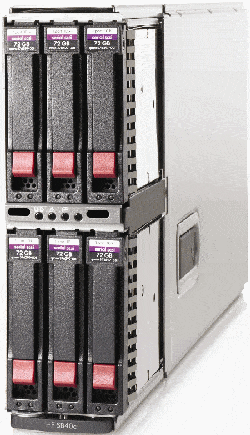IBM may lead the market for blade servers by a long shot, but HP has beaten Big Blue to market with its first storage blade. IBM doesn’t expect to release its first storage blade until next year.
HP said at Storage Networking World in Orlando, Fla., today that it has created a dedicated storage blade server to let customers tack on more storage simply by popping thin servers into a chassis.
Used in conjunction with HP BladeSystem c-Class server blades, the HP StorageWorks SB40c storage blade serves up data for applications such as file and print, mail and messaging, video streaming, databases and distributed file systems.
The SB40c consists of six disk drives with an internal RAID controller that sits next to a BladeSystem server, providing up to 876 more gigabytes of direct-attached storage (DAS) capacity to each blade within an HP BladeSystem c-Class enclosure, said Kyle Fitze, director of SAN marketing for HP StorageWorks.
 |
HP SB40c. Source: HP |
“This is important because, as we’re ramping our blade system business, we’ve noticed that some applications require more capacity or more spindles than exist on a BladeSystem server,” Fitze said, noting that the SB40c acts like an external enclosure or a JBOD for a rack-mount server.
Supporting small form factor serial-attached SCSI (SAS) or SATAdrives, the SB40c’s capacity and low power consumption accommodate the space and power constraints of data centers.
This is a key sales point systems vendors use to appeal to cost- and space-constrained businesses that are tired of large disk arrays and server overheating their data centers.
The SBC40c will be available in mid-November for $1,599.
HP’s storage blade is part of the Palo Alto, Calif., company’s strategy to power everything in a datacenter with a blade at a time when companies demand more space and less power consumption.
Storage blades could be a nice alternative for companies with such concerns. But will providing a storage blade subsume traditional disk arrays?
Fitze said HP does not believe the SB40c will cannibalize its XP, MSA or EVA storage lines, noting that the value lies in offering customers more choice.
“Customers that are using applications that need more DAS can use this,” Fitze said. “If they need scalable network storage, they can connect to a SAN array or even a NAS product outside of the BladeSystem enclosure.”
The notion of situating server and storage blades side by side points to the increasingly tight synergy between data servers and storage systems. HP last year unveiled management software for such integration.
Though HP has beat IBM the storage blade form factor, IBM, which currently corrals more than 40 percent of the total blade server market, has one in the works. Sun Microsystems makes a network-attached storage (NAS) blade.
HP today also introduced two offerings within the HP StorageWorks Enterprise Virtual Array (EVA) family.
The HP StorageWorks VLS300 EVA Gateway emulates a tape library, scaling beyond 500 terabytes of capacity and piping data at more than eight TB per hour to speed backup and recovery in storage area networks (SANs). The capacity is equivalent to 128 virtual tape libraries.
Also available mid-November, the gateway is $57,750 for the base unit, which includes 2 nodes plus switches with 25 LUNs or 50 TB.
Finally, the HP StorageWorks EVA4000 SAN Starter Kit makes storage management easier for small-and medium businesses (SMBs), a critical function for businesses with overworked IT staffs.
The kit’s interface automatically discovers switches and other gear and configures arrays with a few mouse clicks. The software is available now for $33,100.
Article courtesy of InternetNews.com


